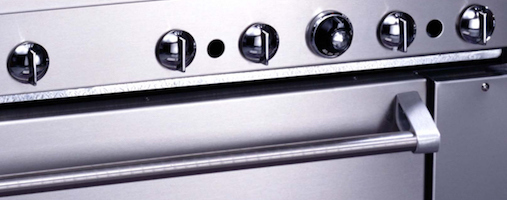In our decades as a supplier of appliance parts and assemblies, we’ve found that metal appliance handles are best made using three manufacturing methods: roll forming, which is very cost effective, hydroforming, which allows for more complexity and flexibility without sacrificing strength, and tubular stamping, which combines economy, strength, and flexibility at high volumes.
Here are more details about each of these manufacturing methods for metal appliance handles.
Roll Forming’s Cost Benefits
In roll forming, also known as cold roll forming, a long strip of coiled metal is passed through a series of custom-designed arc and sweep rollers to produce a specific cross-section profile and a variety of bends, curves, or other special features.
Although other processes are better suited for complex or asymmetric profiles, this method is a straightforward, cost effective solution for simple, symmetrical metal appliance handles, such as those used on many oven range and refrigerator models.
C-shaped, closed, and round cross-section profiles can be easily produced with roll forming, and roll forming accommodates almost any metal, which can be coated, painted, or plated. In addition, as the name “cold roll forming” implies, the process involves no heat. This lack of heat has many benefits, among them: expanding materials options, reducing tooling wear and tear, and helping to minimize the amount of wasted material.
And while roll forming can’t match hydroforming or tubular stamping in terms of part complexity, it does accommodate options such as notching, perforation, and punching. These operations can be incorporated into the roll forming process, rather than as a separate step, making it a highly efficient method for manufacturing metal appliance handles.
Tubular Hydroforming’s Many Options
We specialize in thin-wall tubular hydroforming process for producing complex, lightweight parts and pioneered the use of hydroforming in the appliance industry when we helped bring the first hydroformed appliance handles to market back in 1996.
Hydroforming, as the name implies, involves using water in a pressurized mold to shape components. Thanks to the high precision of tubular hydroforming, specifications for appliance handles produced using this method are extremely accurate.
Tubular hydroforming main benefit for appliance handle designers is its ability to produce complex, asymmetrical shapes and smooth cross-sectional transitions from round to elliptical forms.
A variety of metals respond well to tubular hydroforming: Aluminum offers an array of finishes and is lightweight; brass and copper resist corrosion; stainless steel is also corrosion resistant and can be finished to a high luster; titanium alloys have a high strength-to-weight ratio; and cold rolled steel is economical, easy to work with, and accommodates a variety of finishes.
When it comes to costs, hydroforming produces minimal waste and can be feasible for everything from small-quantity projects such as prototyping to high-volume production runs. In addition, a variety of parts can also be formed without retooling and surface finishes can be applied in fewer steps than with stamping.
Tubular Stamping’s Economy of Scale
Tubular stamping involves performing a series of stamping operations on flat metal stock, resulting in a tubular component.
The tube stamping process starts with punching out a blank from a coil of sheet metal and shaping it into a U profile. The legs of this piece are then rolled to reduce the space between the rolled ends, and then the piece is manipulated again to close the gap. Additional steps are then employed to tighten and close the seam and customize it in a number of different ways — including producing asymmetrical profiles, coining, and hemming.
Tubular stamping is a great option for high-volume production runs of metal appliance handles. The successive stamping operations require a significant investment in tooling, but that can be amortized across high volumes and offset by savings on materials since tubular forming starts with flat-stock metal rather than formed or welded tube stock.
Finding the Right Process to Manufacture Your Metal Appliance Handles
All three manufacturing methods detailed above produce strong, lightweight, and economical parts. But selecting the right production process for your metal appliance handles needs really depends on your part design, how many you need, and the expertise of the manufacturer you choose to partner with.
If you’re at the point where you’re ready to have that conversation, reach out and contact a Mills Products sales engineer. We’ll be happy to discuss your project and weigh whether roll forming, tubular hydroforming, or tubular stamping is the best fit.


